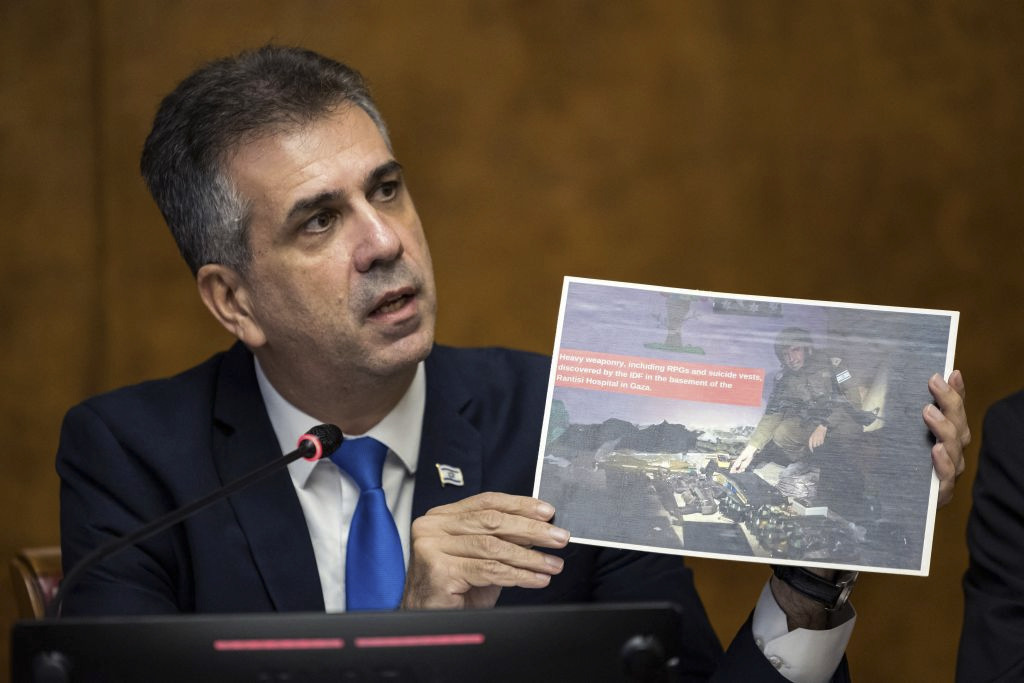
Kommentarer
The Strategy of Atrocity in the Gaza War

«People should either be caressed or crushed. If you do them minor damage they will get their revenge; but if you cripple them there is nothing they can do. If you need to injure someone, do it in such a way that you do not have to fear their vengeance.» — Niccolo Machiavelli.
Imagine for a moment the following story in the New York Times:
October 12, 2023, Gaza City. In an outpouring of rage, the population of Gaza has taken to the streets to protest the attacks of October 7, causing the collapse of the Hamas government. Local reports are confused, but it appears that several hundred Hamas officials have been killed by angry mobs of Palestinian citizens. Surviving Hamas leaders are reported to be fleeing Gaza. Unverified videos of what appear to be the gruesome deaths of several senior Hamas officials have been posted on social media.
But that is not the world we live in.
LESSONS LEARNED FROM OCTOBER 7
Short of the destruction of Israel, there will not be any sovereign Palestinian state in Gaza for the foreseeable future. This is not because of what Hamas did on October 7. This is because those actions occurred with the support and collaboration of the people of Gaza, thousands of whom streamed across the border to loot, rape and take hostages in the wake of the terrorists.
Unfortunately, talking about Hamas as an entity separate from the Gazan population is disingenuous and misleading. Every indication, ranging from opinion polls to the tangible actions of much of the Gazan population, indicates that Hamas’ actions are viewed in a positive light by many of the Gazan people. For the United States to reward these actions with statehood, autonomy, or funds for rebuilding would be stark madness.
There are only two paths to a durable peace between the Palestinian people and Israel:
- The first is for the Palestinians to achieve a comprehensive military victory, which would result in the immediate rape, torture and murder of any Israelis who do not manage to flee.
- The second is for Israel to achieve a decisive victory and the unconditional surrender of Hamas, at which point the long process of remaking Gazan society can begin.
The third alternative, and the default option — probably backed by Qatar, the lead negotiator for the release of the hostages but also the main patron of Hamas and other terrorist groups (here and here) — is a forever war in which neither side can achieve victory. Hamas will continue to deploy asymmetric military means, such as terror attacks and the launching missiles at civilian targets, to secure several goals:
First, to remind all Palestinians that Hamas is taking the lead in destroying Israel; second, to survive as a military force; third, to reignite the conflict with Israel when, in the future, a strategic opening presents itself; and, fourth to generate ongoing strife and thus suffering for the Gazans, responsibility for which can be shifted onto Israel in the international media and through international bodies including the United Nations.
A WAR OF ATROCITY
In Gaza we are seeing a new and innovative type of war being fought: Hamas is perhaps the first regime in recorded history to fight a war designed to maximize casualties among their own population. Hamas created a circumstance, through the strategic deployment of atrocity, in which Israel was faced with the choice of either not responding or responding with overwhelming force. The former would result in the collapse of the Israeli government, and in Israel’s adversaries perceiving them (correctly) as devastatingly weak, due to either an unwillingness or an inability to defend themselves. The latter would inevitably result in international condemnation for the effect on Gazan non-combatants, with false accusations of «disproportionality» and alleged violations of the laws of war. Hamas’s strategy of atrocity is both brilliant and evil.
Initially, commentators and Israeli politicians noted a similarity to the performative tactics of atrocity deployed by ISIS (the Islamic State in Iraq and Syria). However, the connection between ISIS and Hamas goes much deeper than most realize. According to Ofira Seliktar, a scholar of intelligence failures, ISIS and Hamas learned strategy from the same playbooks. Seliktar argued that Hamas
«… develop[ed] a jihadist strategy based on two popular jihadists books: One, Issues in the Jurisprudence of Jihad … also known as Jurisprudence of Blood, or the ‘jihadist bible,’ provided theological justification for inflicting extreme violence on enemies, as well as a list of tactics such as beheading, torturing, or burning prisoners alive. The second book, Management of Savagery, urged [jihadists] to commit ‘attention-grabbing’ atrocities to attract recruits and sow fear in the enemy’s hearts.»
Furthermore, Hamas’s «embedding» its fighters among civilians residing in Gaza, effectively using Palestinians as human shields – another atrocity – is justified by the principles of asymmetric warfare. According to Seliktar, the media’s description of the relationship between Hamas and the residents is
«… confined mostly to the description of the[ir] suffering…. The IRGC-QF [Iranian Islamic Revolutionary Guard Corps–Quds Force] doctrine of using human shields was based on Brigadier General S. K. Malik’s The Koranic Principle of War. Adapted to asymmetrical conflicts, it stipulated that embedding among non-combatants could level the playing field when engaging Western armies obligated to follow the humanitarian laws of war.»
Westerners clearly misperceive Hamas when they imagine that their actions on October 7 were spontaneous and opportunistic; rather, it appears that the strategy of atrocity was theoretically informed, well designed, and then executed to elicit an overwhelming Israeli response and to put the Gazans at peril.
Why is a strategy of atrocity even more dangerous than it might appear? Because it is an attack on the central ideas underlying the laws of war and the Westphalian order.
If Hamas is allowed to achieve any kind of victory from the deployment of this strategy, we can expect to see others re-use the same playbook. This is a likely and tragic outcome that Western powers should make considerable sacrifices to avoid. A lesson needs to be taught: Atrocity as strategy results in the swift and utter destruction of the regime deploying it.
This is not a time for Western leaders to insist on restraint by our allies.
Failing to swiftly destroy Hamas and directly punish Hamas’s backers in Iran and Qatar will teach sympathizers in other parts of the Muslim world that strategies of atrocity should be added to the playbook of regimes challenging U.S. allies around the world. Even worse would be for Hamas to actually achieve a strategic victory and gain a Palestinian statehood; such an outcome would ensure that atrocity becomes a standard and widely used strategy for at least a generation to come.
ASYMMETRIC WARFARE AND THE LAWS OF WAR
The laws of war — primarily a Western innovation — are being weaponized by the enemies of the West, who do not subscribe to Western culture. Laws of war make a certain amount of sense when there is a cultural consensus among potential combatants that there is a minimum set of standards for the conduct of war. But with no independent third-party sovereign who can enforce rules on combatant powers, any such laws of war will hold only to the extent that the leaders elect to obey them and ensure that their own soldiers comply with them. When one state that subscribes to the concept of human rights and military restraint is at war with an organization that recognizes no such restraint, the balance of advantage flows to the party who recognizes no limits, unless there is some exogenous benefit associated with adhering to the laws of war and accepted standards of human rights.
Today, the United States and our allies find ourselves at war with states and non-state entities who do not subscribe to the laws of war. Even if some have signed the relevant treaties, their leadership has demonstrated a profound lack of interest in enforcing the relevant laws regarding their own soldiers. For instance, Russia, in their invasion of Ukraine, has committed a never-ending series of atrocities and war crimes, and has deliberately targeted civilians. Russian aims seem to include terrorizing the civilian population into submission and erasing Ukrainian identity in the areas they occupy.
What is even worse is that, in some cases, the core legitimacy of adversary regimes is predicated on an agenda that is in contravention of the assumptions that undergird the laws of war. Hamas’s explicit, avowed goal is the destruction of Israel and the death of all Jews, worldwide (here, here and here).
Hamas, ISIS and even the Palestinian Authority (PA) recognize no meaningful distinction between civilians and combatants – either among their enemies, or within their own populations. As Itamar Marcus, founder of Palestinian Media Watch, points out:
«What is clear from both the new PA announcements and past policy is that the PA does not differentiate between Hamas terrorists who committed atrocities after invading Israel on Oct. 7, the Hamas terrorists killed by Israel in the ensuing war, and civilian non-combatants killed in the Gaza Strip while being used as human shields by Hamas. They are all considered ‘Martyrs’ whose families are eligible to receive stipends of 1,400-12,000 shekels [$375 – $3,215] per month for life.»
This distinction between combatants and civilians is a key concept in the modern understanding of what constitutes a nation-state. What restraint is warranted in a war, provoked by a terrorist attack on a liberal-democratic, pluralistic society, toward a regime that celebrates murder, mass rape, kidnapping, and every imaginable flavor of savagery and terror? The answer is tragically simple: The laws of war were designed to deal with conflicts between states that recognize a clear distinction between combatants and civilians.
If organizations like Hamas are permitted to hide «amongst the people«‘ and to achieve victory by flouting the accepted rules of civilized warfare, then the rules of civilized warfare will become nothing more than an intellectual weapon deployed against the West, restraining the West from defending its institutions and culture, and ultimately leading to its defeat.
THE DOCTRINE OF PROPORTIONALITY
Proportionality – one of the key principles of the laws of war – is a widely misunderstood term. There is a popular understanding and a technical, legal one. According to a posting available on a West Point website:
«Proportionality plays a key role in international humanitarian law (IHL). It is essential to regulating the conduct of hostilities, requiring that the expected incidental harm is not excessive in relation to the anticipated military advantage….»
Lord Guglielmo Verdirame, in the UK House of Lords, articulated the legal doctrine of proportionality clearly and succinctly:
«Proportionality does not mean that the defensive force has to be equal to the attack. It means you can use force proportionate to the defensive objective – to stop, repel and prevent further attacks. Israel’s war aims are consistent with proportionality in the law of self-defense.»
Verdirame suggests that the legitimacy of the military advantage a state seeks to secure depends on its war aims while engaging in self-defense. What are Israel’s official war aims?
Prime Minister Benjamin Netanyahu has stated, in a recent interview, that Israel’s war aims are: «One, destroy Hamas. Two, free the hostages…. Three, ensure that Gaza never again poses a threat to Israel.» Given that Hamas’s leadership is already threatening a series of further attacks (here and here), it is clear that the force that Israel has deployed to date has not yet enabled them to achieve their war aims.
However, in the popular imagination, the doctrine of proportionality is intended to restrain states from using overwhelming force and doing excessive harm to noncombatants. The mainstream media has stoked the notion that Israel has committed war crimes by allegedly killing 30,000 Gazans, when only 1,300 people – Israeli, French, American and other countries’ citizens – were killed on October 7. Never mind that the total number of Gazans killed is supplied by a Hamas-run agency of the Gazan government; and the number does not differentiate between Hamas terrorists and noncombatants. The allegation made in the popular press is that the «disproportionate» number of deaths means war crimes must have been committed by Israel.
Consider Japan and Germany at the end of World War II: Approximately 6 and 12 percent of their total populations had been killed, and many more wounded, before unconditional surrender was achieved. By contrast, only 0.32% of the U.S. population was killed. A similar campaign today would result in more than ten times the reported casualties in Gaza–perhaps 300,000 or more.
These comparisons raise the problem of proportionality of outcome, but there is another problem: proportionality given disparate military capabilities. Some argue that Israel, because of their comparative strength, has a responsibility to attack only Hamas, and avoid harm to the civilian population that Hamas uses as human shields. Such popular statements amount to a doctrine that an aggrieved party to a conflict, having been blinded in one eye by an enemy, may seek only an equal harm, «an eye for an eye.» Such logic has no basis in international law or in the laws of war and would produce absurd outcomes: A killing for a killing, a mutilation for a mutilation, a beheading for a beheading, a rape for a rape.
The immediate effect of this hazily defined colloquial doctrine of «proportionality» is to delegitimize Israel’s war on Hamas. But the long-term effect is something quite different: The popular accusation of disproportionality is, in point of fact, aimed to prevent Western-aligned nations from achieving decisive victories. Even when the allies of the United States have the military capacity to break the will of the enemy, thereby imposing peace on the defeated, they will be forced to resort to fighting forever wars.
The claim of disproportionality is but one charge of war crimes leveled against Israel and the Israel Defense Forces. The International Court of Justice at the Hague, non-governmental organizations (NGOs), and even Israel’s ally, the United States government, are investigating allegations of Israeli war crimes, when Israel has reportedly done more than any other military to minimize harm to civilians. These accusations nevertheless include, among others: genocide against the Palestinians, ethnic cleansing, collective punishment, denial of humanitarian relief, the indiscriminate killing of civilians, and failure to provide adequate warning of an impending attack. Israel will undoubtedly respond to both formal charges and media accusations.
The scale of the undisputed destruction and human tragedy in Gaza has triggered dramatic and relentless media attention, which has significant and immediate strategic consequences for both Israel and Hamas. The widespread use of social media results in the rapid and far-reaching broadcast of both news and propaganda, with text, images and videos, designed and optimized to promote outrage and polarization, being pushed to billions of people around the world. Likewise, Israel’s choice to limit media coverage and publication of the images and videos of the October 7 Hamas atrocities and their aftermath has had significant effects on the perception of Israel and of the attacks themselves (here, here, and here).
The first incident to garner wide media attention was when a British Broadcasting Company (BBC) reporter indicated that an explosion outside a hospital in northern Gaza on October 18, 2023 was the result of an Israeli attack:
«The Israeli military … have said they are investigating, but it is hard to see what else this could be, really, given the size of the explosion, other than an Israeli air strike, or several airstrikes.»
Within one hour of the attack, the Gaza health ministry, run by Hamas, placed the death toll at 500; the BBC echoed this claim by indicating that the number of dead was in the hundreds. On October 19, 2023, the BBC walked back its accusation. In commenting on these events, Lord Guglielmo Verdirami stated:
«When a serious allegation is made, particularly one that could constitute a war crime, the immediate response of the law-abiding belligerent will be to say, ‘We are investigating.’»
The non-law-abiding belligerent, by contrast, will forthwith blame the other side and even provide surprisingly precise casualty figures. The duty to investigate is one of the most important ones in armed conflict. What happened in the way in which the strike on the hospital was reported is that the side that professes no interest whatever in complying with the laws of armed conflict was rewarded with the headlines that it was seeking.
The irresponsible reporting by the BBC, accompanied by pictures of a blast site, was investigated, disproven and repudiated by Israel and Western governments. They determined that the blast was caused by a rocket launched from within Gaza by Palestinian Islamic Jihad.
Amnesty International insisted on October 20, 2023 that its research revealed that the Israel Defense Force (IDF) failed to notify civilians of its intent to attack housing in the densely populated Gaza, leading to the deaths of Palestinian families. The headline of its posting captured the organization’s intent: «Damning Evidence of War Crimes as Israeli Attacks Wipe Out Entire Families in Gaza.» Furthermore, Amnesty International claimed that Israel had not allowed them to enter Gaza on fact-finding missions, thereby implying that Israel was hiding something rather than that Amnesty might not be acting in good faith.
Before uncritically accepting such accusations, what we should appreciate is the comparative data placing Israel’s destruction of Gaza in pursuit of its war aims in historical context. According to John Spencer, who holds the chair of urban warfare studies at the Modern War Institute of the United States Military Academy (West Point), the war in Gaza is not comparable to any other conflict in modern history, most notably in the systemic embedding of Hamas’s warriors and war materiel in and below private homes, hospitals, schools, mosques, and UNWRA facilities. Such embedding is, in itself, a war crime.
«The truth,» Spencer argues, «is that Israel has painstakingly followed the laws of armed conflict and implemented many steps to prevent civilian casualties…..» He compares the number of casualties in Gaza with the devastating and overwhelming number of lives lost in other modern urban battles – in Mariupol, Chechnya, Syria, Dresden, Tokyo, Manila, and Mosul.
One unmistakable implication of Spencer’s analysis is that Israel is being held to a different, more demanding standard of behavior than Great Britain, Russia, and the United States – three powers that had decided in 1945 to avoid forever wars by seeking victory, even at devastating cost to their adversaries.
HAMAS AND THE ENDING OF FOREVER WARS
Hamas provides an excellent example of a forever war: They have functioned for almost 20 years as a government in Gaza, exercising a local monopoly on violence in a specific territory. Since 2006, each period of relative peace in Gaza has been used by Hamas as an opportunity to re-arm and prepare for the next series of attacks. In the months leading up to October 7, Hamas remained relatively quiet, to lull the Israelis into a sense of security, while they prepared to launch a devastating attack. Many of the political elite and military leadership in Israel believed in what turned out to be an unjustified hope: That through economic engagement (here, here, and here), Gaza would become more prosperous, the Gazans would abandon their bellicosity in favor of upward mobility, and that Hamas was becoming fully occupied with governing. Others might have hoped that Hamas’s genocidal rhetoric was a form of political posturing. Sadly, they could not have been more wrong.
Hamas’s leadership clearly understands that they do not have the force of arms or the external support required to defeat Israel in any conflict waged within the ambit of the laws of war. Instead, Hamas engages in terrorist attacks that appear intended to demand responses that will provoke chagrin and division among Israel’s Western backers. This enhances Hamas’s standing within the Muslim world, while subjecting ordinary Gazans to the terrible consequences of a war that Hamas cannot win, but which it sometimes seems the West does not want Hamas to lose.
The Palestinian population has been supported by a UN agency, the United Nations Relief and Works Agency (UNRWA). The Palestinians, unlike other nations, peoples or ethnic groups, have an exclusive UN agency dedicated to their well-being, but accompanying that privilege are restrictions: Palestinians are not permitted to resettle as citizens into the populations of host countries. Palestinians who have been in Jordan, Lebanon, and Syria for three generations are treated as stateless non-citizens and barred by law from working or integrating into their new home countries. Even today, Egypt keeps its doors closed (absent massive bribery or political influence) to Palestinians seeking to flee the war zone.
Providing welfare to these refugees keeps a despondent, hate-filled, and expanding population mobilized for the purpose of terror against Israel. Given that the leadership of the refugee camps, Hamas, Islamic Jihad, and even Fatah (here, here, and here) have all been committed to the destruction of Israel, the deep question is this: Why should the populations that have supported such organizations, and which refuse to abide by the laws of war, receive benefits from the United Nations and Western institutions? Why should the Israelis be compelled to allow aid into Gaza, when Hamas continues to hold hostage not just Israelis but also Americans? Under the guise of benevolence and generosity, these international organizations promote forever wars.
By way of contrast, after World War II, the Allies were feared in large part because they demonstrated a willingness to use overwhelming force to achieve victory. While they did not deliberately target civilians, they did not hesitate to take actions that would unquestionably result in large numbers of civilian casualties in order to destroy legitimate military targets and to undermine the will of their adversaries to continue fighting. Such actions have been a necessary part of achieving victory in most wars throughout human history.
The liberal-democratic regimes of the world cannot accept being hamstrung by the popular concept of proportionality, applied asymmetrically to adversaries who recognize no such restraint. The use of overwhelming force to achieve victory results in wars that actually end, rather than dragging on indefinitely. Regimes that support terrorism, that have explicitly genocidal agendas, and that fail to recognize the distinction between civilians and combatants, need to be attacked and destroyed with the full force of Western arms. Any appeal by them for restraint or to the laws of war should be predicated on their explicitly disavowing and enforcing both genocidal aims and terrorist means to achieve these ends.
DECISIVE VICTORY AND UNCONDITIONAL SURRENDER
Distinctions between civilians and combatants are explicitly an artifact of Western strategic culture. The adversaries of the West today do not partake of this strategic culture, and have their own, utterly distinct, ways of war. To the extent that they comply with Western ideas about limited warfare, human rights, or civilian-military distinctions, it is because they fear the consequences of prompting a response from the United States. Even American hegemony proved insufficient to stop Srebrenica, Xinjiang, Darfur, Grozny, or other massacres too numerous to mention.
What is the take-away from these instances of government-initiated atrocity? When a regime that does not recognize a distinction between civilians and combatants engages in terrorism, that government will, in all likelihood, use their own people as human shields, hostages or human sacrifices in service of generating sympathy among the populace of their enemies. The noncombatants that have selected and supported such a government have created a circumstance in which, for the rules-based international order to survive, the government must be destroyed.
If the type of warfare that we have seen from Hamas is allowed to succeed, and is not met with overwhelming violence and utter defeat, it will become the standard approach for those challenging Western dominance. If, however, we want to live in a world where the laws of war mean something, then the penalties for deliberately flouting them need to be terrible. Otherwise more regimes will be tempted to gain advantage through strategies of atrocity.
The US should stop imposing on our allies a doctrine of defeat. While civilians should not be deliberately targeted, our allies should be encouraged to use overwhelming force to achieve swift and decisive victories over regimes that promote atrocity. Civilian casualties, in such a circumstance, are both regrettable and inevitable.
The United States should back Israel to achieve a decisive victory in Gaza. What does a decisive victory mean? Hamas’s unconditional surrender.
Anyone who participated in the events of October 7, anyone who passed on orders, and anyone who provided material support, needs to be either killed, or captured and put on trial. The same goes for anyone involved in the capture, detention or abuse of the hostages. Anyone who was committed to the Hamas regime as an administrator, politician or tax collector needs to be detained, debriefed, and held to account for any actions that supported the invasion of Oct. 7. At the end of this war, the military and political leaders responsible for those attacks should have either been killed in battle, tried for their complicity in war crimes, or should be fleeing for their lives, like the leadership of the Nazi party after World War II. Furthermore, all of the international organizations complicit with Hamas should no longer have any role in the governance or support of Gaza, especially UNRWA.
In particular, the Qatari government, which «supports all Islamist terrorist organizations (ISIS, Al-Qaeda, Taliban, Hamas, and Hezbollah)» (here and here), and provides safe haven for the Hamas leadership, should also be held to account. Iran, which funds and directs terrorist proxies across the Middle East and beyond, needs to be sanctioned, contained, and threatened with the credible use of devastating force for its role. Finally, the day after hostilities end, the Israelis must protect the new Gazan government from being undermined by renewed efforts to support terrorism and remilitarization.
THE DAY AFTER UNCONDITIONAL SURRENDER: WINNING THE PEACE
The Israelis will need to make a significant effort to de-radicalize the population of Gaza over the next generation or two. They will need to set up a regime to govern on their behalf, though the Gazans will no doubt regard such politicians as Quislings. By imposing a government that at least attempts to enforce basic civil rights – access to birth control, freedom of religion, freedom of speech, security for private property, equal justice under the law – and an educational program that is intended to de-radicalize the population, perhaps over 50 years or more – some sort of durable accommodation can be achieved. In the meantime, the best that can be hoped for is security and stability. No outside actor can make this happen. The alternative is a forever war. The only path to peace, other than the destruction of Israel, is through a comprehensive Israeli victory and an unconditional surrender by Hamas in Gaza, and a post-war arrangement ensuring that the Gazans will not be able to commit such atrocities in Israel again.
___________________________________________________________
Michael Hochberg earned his PhD in Applied Physics from Caltech and is currently a visiting scholar at the Centre for Geopolitics at Cambridge University. He is the President of Periplous LLC, which provides advisory services on strategy, technology, and organization design. He co-founded four companies, representing an exit value over a billion dollars in aggregate, spent some time as a tenured professor, and started the world’s first silicon photonics foundry service. He co-authored a widely used textbook on silicon photonics and has published work in Science, Nature,National Review, The Hill, American Spectator, RealClearDefense, Fast Company, and Naval War College Review. Michael’s writing can be found at longwalls.substack.com, and his Twitter is @TheHochberg.
Leonard Hochberg taught at Stanford University (among other institutions), was appointed a Fellow at the Hoover Institution, and co-founded Strategic Forecasting, Inc. (i.e., STRATFOR). He has published work in Social Science History, Historical Methods, The Journal of Interdisciplinary History, Orbis, National Review, The Hill, American Spectator, RealClearDefense, Cartographica, and Naval War College Review. He is a Senior Fellow at the Foreign Policy Research Institute and serves as the Coordinator of the Mackinder Forum-U.S. (www.mackinderforum.org). Len earned his PhD in political theory and European history from the Department of Government, Cornell University.




